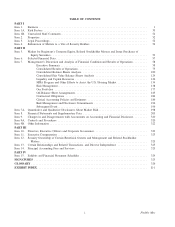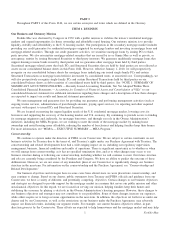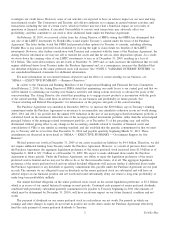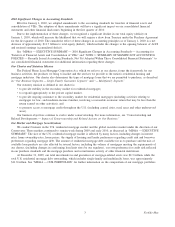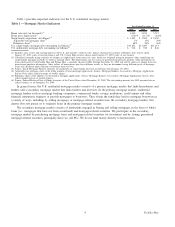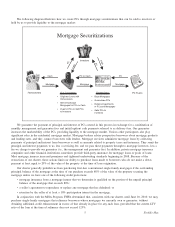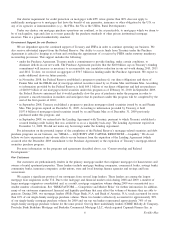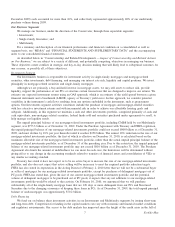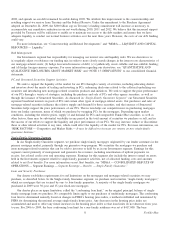Freddie Mac 2009 Annual Report Download - page 12
Download and view the complete annual report
Please find page 12 of the 2009 Freddie Mac annual report below. You can navigate through the pages in the report by either clicking on the pages listed below, or by using the keyword search tool below to find specific information within the annual report.conforming loan limit for a one-family residence for 2010 will remain at $417,000, with higher limits in certain “high-cost”
areas.
As part of the Economic Stimulus Act of 2008, the conforming loan limits were increased for mortgages originated in
certain “high-cost” areas from July 1, 2007 through December 31, 2008 to the higher of the applicable 2008 conforming loan
limits, ($417,000 for a one-family residence), or 125% of the median house price for a geographic area, not to exceed
$729,750 for a one-family residence. We began accepting these “conforming jumbo” mortgages for securitization as PCs and
purchase as mortgage loans held on our consolidated balance sheets in April 2008. We purchased $91 million and
$2.6 billion of these loans during 2009 and 2008, respectively.
Pursuant to the Reform Act, beginning in 2009, the conforming loan limits were permanently increased for mortgages
originated in separately defined “high-cost” areas — where 115% of the median house price exceeds the otherwise applicable
conforming loan limit. Under the Reform Act’s permanent high-cost area formula, the loan limit is the lesser of (i) 115% of
the median house price or (ii) 150% of the conforming loan limit (currently $625,500 for a one-family residence).
However, a series of legislative acts have temporarily restored the high-cost area limit to up to $729,750. On
February 17, 2009, President Obama signed the American Recovery and Reinvestment Act of 2009, or Recovery Act, into
law. For mortgages originated in 2009, the Recovery Act ensured that the loan limits for the “high-cost” areas determined
under the Economic Stimulus Act did not fall below their 2008 levels.
On October 30, 2009, a Continuing Resolution extended the loan limits established by the Recovery Act through 2010.
With the exception of mortgages purchased under our conforming jumbo offering in 2008 and early 2009, we refer to
mortgages with original principal balances in excess of the base conforming loan limits as “super-conforming mortgages.”
We purchased $26.3 billion of these loans during 2009.
Higher limits apply to two- to four-family residences. The conforming loan limits are 50% higher for mortgages secured
by properties in Alaska, Guam, Hawaii and the U.S. Virgin Islands.
Guarantees
Through our Single-family Guarantee segment, we historically sought to issue guarantees on our PCs with fee terms we
believed would offer attractive long-term returns relative to anticipated credit costs. Under conservatorship, and given the
current economic environment and our public mission to provide increased support to the mortgage market, we currently
seek to issue guarantees with fee terms that are intended to cover our expected credit costs on new purchases and that cover
a portion of our ongoing operating expenses. Specifically, our ability to increase our fees to offset higher than expected
credit costs on guarantees issued before 2009 is limited while we operate at the direction of our Conservator, and we
currently expect that our fees will not cover such credit costs.
We enter into mortgage purchase volume commitments with many of our larger customers in order to have a supply of
loans for our guarantee business. These commitments provide for the lenders to deliver us a specified dollar amount or
minimum percentage of their total sales of conforming loans. If a mortgage lender fails to meet its contractual commitment,
we have a variety of contractual remedies, which may include the right to assess certain fees. Our mortgage purchase
contracts contain no penalty or liquidated damages clauses based on our inability to take delivery of presented mortgage
loans. However, if we were to fail to meet our contractual commitment, we could be deemed to be in breach of our contract
and could be liable for damages in a lawsuit.
The purchase and securitization of mortgage loans from customers under these longer-term contracts have pricing
schedules for our management and guarantee fees that are negotiated at the outset of the contract with initial terms typically
ranging from three months to one year. We call these transactions “flow” activity and they represent the majority of our
purchase volumes. The remainder of our purchases and securitizations of mortgage loans occurs in “bulk” transactions for
which purchase prices and management and guarantee fees are negotiated on an individual transaction basis. Mortgage
purchase volumes from individual customers can fluctuate significantly. Given the uncertainty of the housing market in 2009,
we entered into arrangements with existing customers at their 2009 renewal dates that allow us to change credit and pricing
terms faster than in the past; among other things, we are seeking to renew such arrangements for shorter terms than in the
past. These arrangements, as well as significant customer consolidation discussed above, may increase volatility of flow-
business activity with these customers in the future.
Securitization Activities
We seek to securitize substantially all of the newly or recently originated single-family mortgages we have purchased
and issue PCs that can be sold to investors or held by us. As discussed below, we guarantee these mortgage-related securities
in exchange for compensation. We seek to generally hold PCs instead of single-family mortgage loans for investment
purposes, primarily to provide us with flexibility in determining what to sell or hold and to allow for more cost effective
interest-rate risk management.
9Freddie Mac


